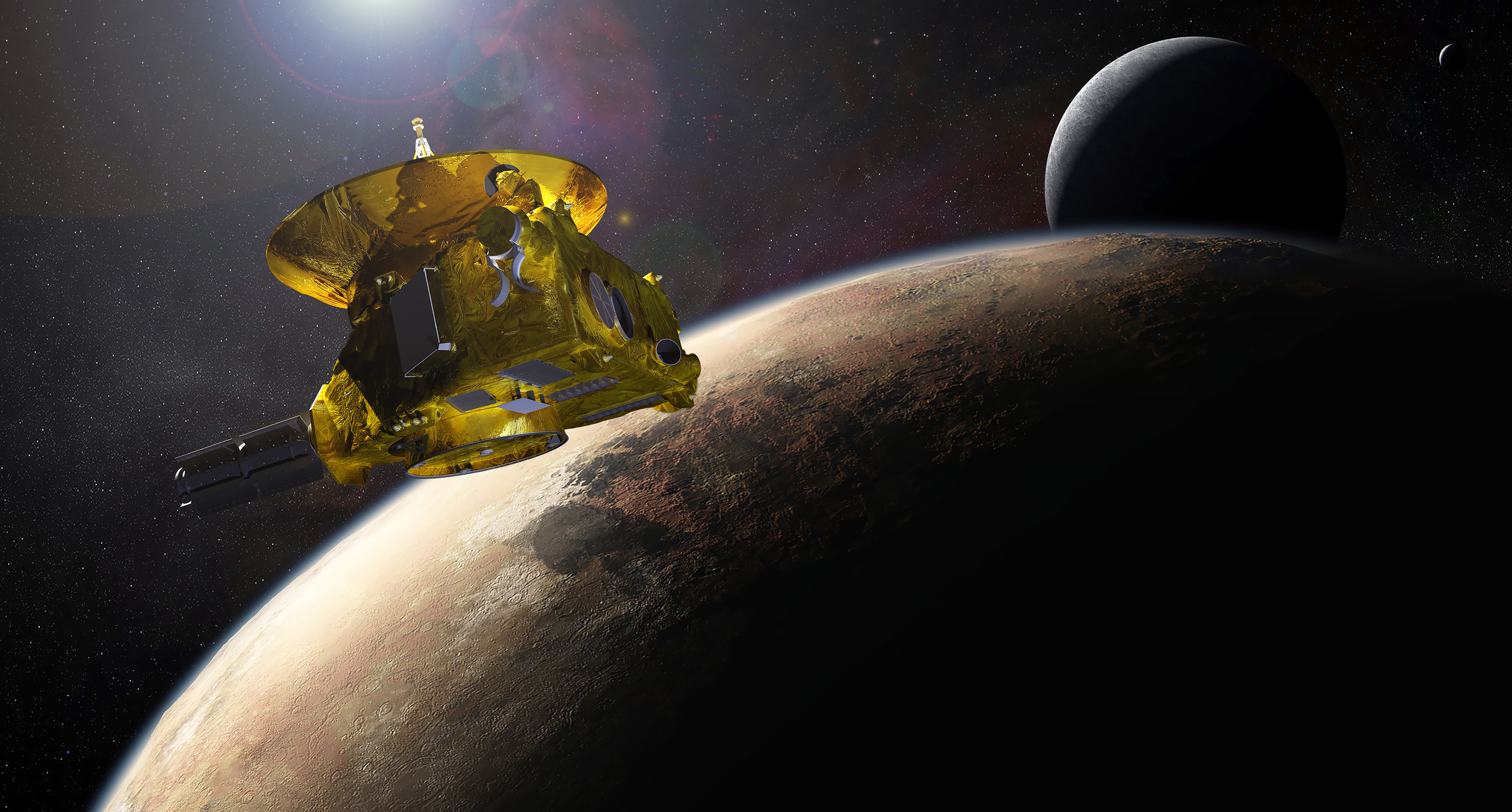Believe it or not, we are living in a golden age of space exploration
The feat of NASA's New Horizons spacecraft should stand alongside the taming of the oceans and the first flight of the Wright Brothers


It says so much about the nature of space exploration that one reflexively uses the pronouns "we" and "us" when discussing it. I can think of no other peaceful human endeavor where that is the case.
We didn't map the human genome; scientists did. We did not discover the Higgs boson. Physicists get the credit. When Olympic world records are set, nobody watching from his or her couch says, "Well, it looks like we are faster now." But we went to the moon and we're looking for life on Mars. (Conversely, we invaded Afghanistan. We defeated the Nazis. We fought wars in Iraq and Vietnam. Perhaps the wonder of space exploration is the alter ego to the horror of war.)
On Tuesday, July 14, at 7:49 a.m. EDT, we will experience an astounding moment in the history of space exploration. The New Horizons spacecraft will make its closest approach to Pluto and complete what NASA calls the "initial reconnaissance of the solar system." The three-billion-mile journey to Pluto has taken nine-and-a-half years, and New Horizons will be traveling at 31,300 miles per hour during the encounter. If the mission is successful, each and every planet will have first been explored by American spacecraft. Such a clean sweep of the solar system is an achievement akin to the building of the pyramids or the construction of the Great Wall.
The Week
Escape your echo chamber. Get the facts behind the news, plus analysis from multiple perspectives.

Sign up for The Week's Free Newsletters
From our morning news briefing to a weekly Good News Newsletter, get the best of The Week delivered directly to your inbox.
From our morning news briefing to a weekly Good News Newsletter, get the best of The Week delivered directly to your inbox.
Until now, Pluto has been shrouded in mystery. We know very little about the tiny world; its Wikipedia entry is 3,000 words shorter than that of Cybertron, fictional home planet of the Transformers. The best images of Pluto, pre-New-Horizons, each consist of a few blurry pixels. All of that is about to change. The Pluto flyby will deliver to the planetary science community answers long sought on such matters as the planet's surface composition, its topography, and the nature of its atmosphere. The libraries of knowledge soon to be produced are crucial to understanding the workings and origin of our solar system, and thus understanding the origin of life. Meanwhile, New Horizons will transmit to everyone — scientist and layperson alike — photographs of a new world in astonishing detail. Once the flyby is complete, the totality of data collected will take 16 months to arrive here on Earth.
This mission was not always meant to be. Dr. Alan Stern, who leads New Horizons as its principal investigator, has been working since the late 1980s to get us to the outermost planet. Along the way, he and his colleagues endured six canceled missions to Pluto, including the heartbreaking cancellation of Pluto-Kuiper Express in 2000. "It is not unusual to take a couple of tries to find the right concept," he told me in an interview earlier this year. "It is unusual to get to numbers like six or seven times. And it did take persistence — a lot of persistence — over a fairly long period of time." He said it took 14 years, "and not just by myself but by many people in the scientific community who really wanted this to happen... Had it not been for that persistence, there wouldn't be any mission to Pluto."
In 2002, New Horizons was stripped of its budget by the White House. Stern, who embodies the kind of tenacity otherwise seen only in Disney movies, responded by rallying the planetary science community. Congress eventually forced the issue, fully funding the mission. "You have to really want it," he said. "That's the simplest way I can say it."
The New Horizons team worked tirelessly to complete the spacecraft on budget and on time. Orbital mechanics established a non-negotiable deadline: If the spacecraft didn't launch before the end of January 2006, it would have missed the window for a "gravity assist" from Jupiter — a kind of celestial slingshot that would trim years off of the flight time. New Horizons eventually launched on January 19, 2006 — just under the wire — and Jupiter successfully hurled the spacecraft toward Pluto.
A free daily email with the biggest news stories of the day – and the best features from TheWeek.com
It is thrilling to know that our understanding of the solar system now exceeds the classroom staple of my youth: a yellow lightbulb encircled by variously sized orbs on wires. The Oort cloud and frozen volatiles of today's solar system need three-dimensional computer renderings to be appreciated for their beauty and complexity. And while the march of science is intrinsically exciting, it's hard to shake the feeling that the anticipation building for the flyby transcends classrooms and science books. Pluto has long captured our collective imaginations. We've anthropomorphized it as a small friend far away, and in light of classification mischief by the International Astronomical Union, we have defended it with emotion one has a hard time imagining for Neptune or Uranus.
We look to the stars to find new limits to what human beings can do, and then we overcome those limits. We went to space, and when that wasn't enough, we went to the moon — heretofore, perhaps, the crowning achievement of human civilization. The first planet we looked to for exploration beyond our own was Venus, with Mariner 2 successfully encountering it in 1962. NASA later sent spacecraft to Mars, Jupiter, Saturn, and Mercury. Voyager 2 checked the boxes for Uranus and Neptune in 1986 and 1989. Pluto is the final task in a quest that, in the words of John F. Kennedy, has served to "organize and measure the best of our energies and skills."
The lighting of Pluto is a coming of age for humankind. It is the end of one thing — proving that we can visit any world we so choose — and the beginning of something profound: looking outward, beyond the orbits of the planets, with an eye toward active exploration. Contrary to common lamentations, NASA is not an agency flush with cash (its total budget takes up less than one half of one percent of the federal budget), and it is not an agency adrift. We are, in fact, living in a golden age of space exploration. In a five-year span, humanity will have visited the farthest planet in the solar system and set a course for the Kuiper Belt (long hypothesized, but only discovered in 1992); executed a hair-raising entry, descent, and landing of the Mars Science Laboratory; and rewritten the books on Mercury and Saturn, based on the astonishing discoveries of MESSENGER and Cassini, respectively.
We have two rovers actively studying Mars, and NASA now has a realistic roadmap to get an astronaut there and back. Dawn is the first spacecraft to enter the orbits of two different celestial bodies — Ceres and Vesta. Closer to home, we have a reconnaissance orbiter mapping the moon with extremely high resolution. And that's just NASA. The European Space Agency recently landed a robot on a comet, and concluded a nine-year mission studying Venus. The Indian Space Organization has placed a satellite in the orbit of Mars. (There's so much activity around Mars, in fact, that NASA has had to increase traffic control to protect orbiters from getting too close to one another.) Beyond the asteroid belt, NASA received funding this year for a mission to Europa, one of Jupiter's moons. We hope to find answers there that could transform philosophy, religion, and science in very fundamental ways: Europa might be inhabited. For some, in fact, it's only a question of how complex that life might be. Will we find amoebae, or will we find fish?
Leading all this is New Horizons. Once it passes Pluto, Alan Stern and his team are setting their sights on the Kuiper Belt and the mysterious objects therein. Should NASA approve a mission extension, the New Horizons team, on our behalf, will continue doing what humans have always been best at: seeking out the unknown. Once, some cave was too deep to investigate; the Earth was too flat to sail; that mountain was too high to scale; the ocean too hostile to dive into. Once, some worlds were too far to explore.
"When you look back on the 15th century," said Stern, "the most commonly cited accomplishment of that century are the explorations of the so-called 'New World.' It's very hard to remember much of the politics or much else if you're not an expert, other than that. I suspect a few centuries from now when people look back on our time, that the exploration of space — the open reconnaissance of space by my parents' generation, our generation, and hopefully the next — will be among the most notable activities of this period of time." To that end, New Horizons is impossibly far away, and yet remains intimately close to the human ideal.
David W. Brown is coauthor of Deep State (John Wiley & Sons, 2013) and The Command (Wiley, 2012). He is a regular contributor to TheWeek.com, Vox, The Atlantic, and mental_floss. He can be found online here.
-
 Shots fired in the US-EU war over digital censorship
Shots fired in the US-EU war over digital censorshipIN THE SPOTLIGHT The Trump administration risks opening a dangerous new front in the battle of real-world consequences for online action
-
 What will the US economy look like in 2026?
What will the US economy look like in 2026?Today’s Big Question Wall Street is bullish, but uncertain
-
 Alaa Abd el-Fattah: should Egyptian dissident be stripped of UK citizenship?
Alaa Abd el-Fattah: should Egyptian dissident be stripped of UK citizenship?Today's Big Question Resurfaced social media posts appear to show the democracy activist calling for the killing of Zionists and police
